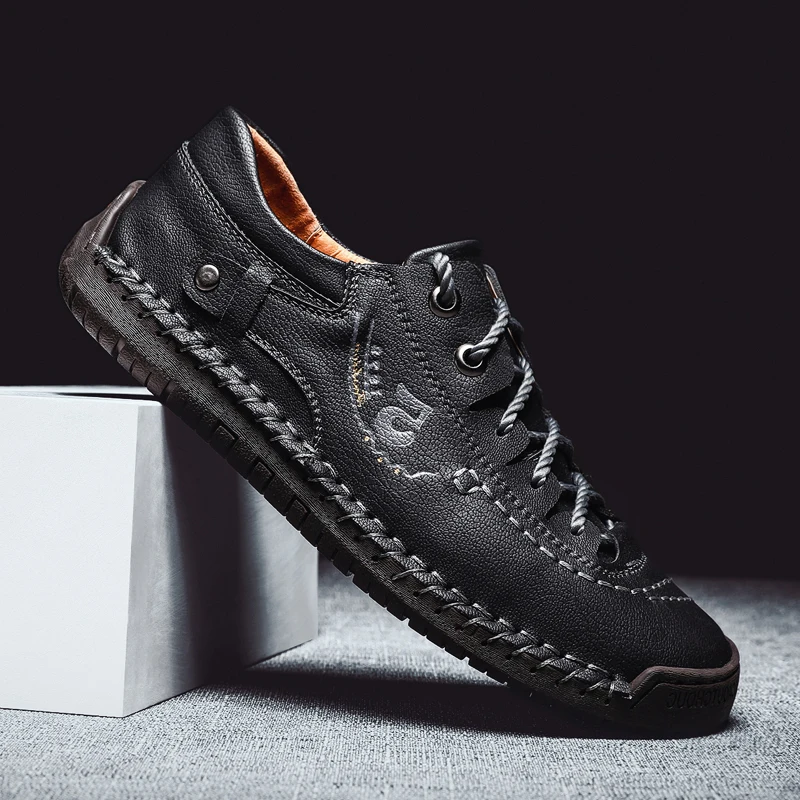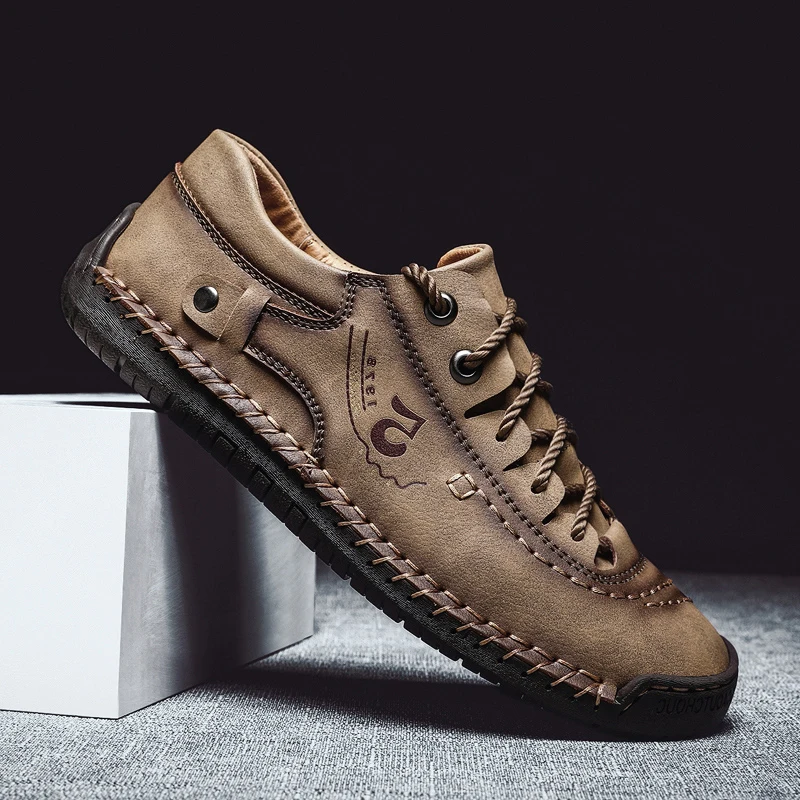Introduction to Synthetic Leather Shoes
What Are Synthetic Leather Shoes?
Synthetic leather shoes, a popular alternative to real leather, consist of man-made materials. Known as vegan leather, fake leather, or artificial leather, these shoes are crafted from synthetic compounds like PU leather (polyurethane) and PVC (polyvinyl chloride). They mimic real leather’s texture and appearance, but without using animal products, catering to ethical consumer preferences. So how to clean synthetic leather shoes?

Benefits of Choosing Synthetic Leather Footwear
Opting for synthetic leather footwear offers numerous advantages. Primarily, they’re cost-effective, reducing the financial barrier to stylish and versatile shoe options. Additionally, synthetic leather shoes are easier to maintain compared to genuine leather, only needing simple household items for care. They’re also a cruelty-free choice, aligning with animal-friendly values. Moreover, these shoes provide considerable durability and can withstand regular wear if properly maintained, making them a smart choice for conscious consumers.
Initial Care and Protection
To extend the life of synthetic leather shoes, initial care and protection are key. Proper steps from the start prevent wear and tear.
Using Protective Sprays for New Shoes
Before stepping out in new shoes, apply a waterproof spray. This guards against water and dirt, keeping shoes pristine.
Importance of Regular Cleaning
Frequent cleaning maintains synthetic leather’s look and durability. Simple tools like cloths and brushes remove daily grime, preserving shoe quality over time.
Cleaning Techniques for Synthetic Leather Shoes
Proper cleaning is critical for maintaining the quality and appearance of synthetic leather shoes. Here are effective methods to ensure your shoes remain in prime condition.
Daily Dirt Removal Process
Start by removing loose dirt daily. Use a soft cloth or a soft-bristled brush. Wipe gently to avoid scratching the synthetic leather surface. This regular care prevents dirt buildup that can lead to deeper stains.
Soap and Water Cleaning Method
For routine cleaning, use mild soap and warm water. Dip a cloth into this solution. Gently wipe the shoes all over. This approach effectively removes most surface dirt and keeps the shoes looking fresh.
Tackling Tough Stains With Baking Soda and Cornstarch
For more stubborn stains or bad odors, use baking soda or cornstarch. Sprinkle lightly on the stains. Gently rub with a clean cloth. Allow it to sit for about 15 minutes. Then, brush off the residue. This method also helps neutralize odors effectively.

Vinegar Solution for Stubborn Stains
Mix equal parts of vinegar and water to tackle tough stains. Apply with a cloth or a soft brush. Rub gently over the stained areas. Rinse with a clean, damp cloth and dry with a towel. This solution helps remove stubborn stains without harsh chemicals.
Understanding Synthetic Leather
What is Synthetic Leather?
Synthetic leather, also known as faux leather or vegan leather, is made from various types of plastics, primarily polyvinyl chloride (PVC) and polyurethane (PU). Manufacturers design synthetic leather to look and feel like real leather. This material is often used in shoes, bags, jackets, and furniture. Its appeal lies in its affordability, variety of styles, and ease of maintenance.
Knowing the composition of your synthetic leather shoes is essential. Different blends of materials may require different cleaning techniques. However, most synthetic leathers are durable and resistant to water and stains. This makes them a great choice for everyday wear.
Why Choose Synthetic Leather?
There are many reasons to choose synthetic leather over genuine leather. First, synthetic leather is often more affordable. It also does not require the same level of care as genuine leather. For example, real leather needs conditioning to stay supple, while synthetic leather usually remains pliable without extra treatments.
Another important advantage is that synthetic leather is generally more stain-resistant. Scuffs and dirt can often be wiped away easily, making these shoes ideal for busy lifestyles. Additionally, synthetic leather is a cruelty-free option, making it appealing for those who prefer vegan products.
Protecting and Conditioning Your Shoes
To keep synthetic leather shoes looking their best, protection and conditioning are crucial. These steps ensure the shoes stay resilient against wear and environmental factors.
The Role of Mink and Coconut Oil
Though not real leather, synthetic shoes can benefit from oil treatments. Mink oil is a popular choice for dark synthetic leather, helping to waterproof and protect. Coconut oil serves a dual purpose. It conditions the material and adds a natural shine to your shoes. Remember to use oils sparingly to avoid over-saturating the synthetic material.
Tips for Proper Conditioning
When conditioning synthetic leather, follow these tips:
- Clean shoes thoroughly before applying any oil.
- Use a soft cloth to gently rub in mink or coconut oil in circular motions.
- Avoid excessive amounts; a little goes a long way.
- After applying oil, allow it to absorb fully before wiping away excess.
- Perform these steps periodically to maintain your shoes’ appearance and flexibility.
By following these simple protective and conditioning strategies, you’ll extend the life of your synthetic leather shoes. They’ll continue to look great and serve you well for many outings to come.
Drying and Storage Practices
Proper drying and storage are vital to maintain synthetic leather shoes. Here’s how to handle them.
Correct Drying Techniques
After cleaning, air dry your shoes away from direct heat. Stuff them with newspaper to keep their shape. Never use heat like radiators or hair dryers.

Best Practices for Storing Synthetic Leather Shoes
Store your shoes in a cool, dry place. Use shoe trees or stuff them to maintain shape. Avoid stacking shoes or placing heavy items on top.
Maintenance and Longevity
To ensure your synthetic leather shoes last, adopt a consistent maintenance routine.
Routine Maintenance Tips
Regularly check for wear and fix minor issues before they worsen. Wipe shoes after each use.
Use a soft cloth or brush to remove dirt and freshen up your shoes. Perform a deep clean when needed.
Follow up cleaning with proper drying and storage techniques to preserve shoe shape and quality.
Remember, gentle care extends the life of synthetic leather.
Protective Measures Against the Elements
Apply a waterproofing spray to shield against rain and spills. Reapply the spray every few months.
Keep shoes away from extreme temperatures to prevent cracking or fading. Dry them away from heaters or direct sunlight.
If your shoes get wet, let them dry naturally by placing them in a well-ventilated area.
The Significance of Shoe Rotation
Switch between different pairs to reduce wear and tear. Give shoes a break to air out and rest.
Rotating shoes also allows any moisture to evaporate, keeping your shoes fresh and preventing odor.
By including shoe rotation in your routine, you invest in your shoes’ longevity.
Concluding Thoughts
As we have explored, caring for synthetic leather shoes is both necessary and manageable. By implementing the outlined steps, your shoes will not only last longer but also remain visually appealing.
Key Takeaways for Synthetic Leather Shoe Care
Proper maintenance of synthetic leather shoes ensures durability and aesthetic appeal:
- Initial Protection is Crucial: Apply protective sprays to new shoes to shield them from dirt and water.
- Regular Cleaning Matters: Use gentle cleaning methods like soft cloths and mild soap solutions. Avoid harsh chemicals to prevent damage.
- Effective Stain Removal: For stubborn stains, use natural options like baking soda or a vinegar solution. These are safe and effective.
- Condition Regularly: Though synthetic, these shoes benefit from occasional conditioning with oils like mink or coconut oil to retain flexibility and luster.
- Dry and Store Properly: Always air dry away from direct heat and store in a cool, dry place. Consider using shoe trees for shape maintenance.
- Rotate Your Shoes: Wear different pairs regularly to reduce wear and prolong each pair’s lifespan.
By adhering to these care tips, your synthetic leather shoes will continue to complement your wardrobe effectively while respecting ethical and environmental standards.